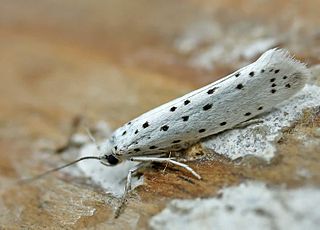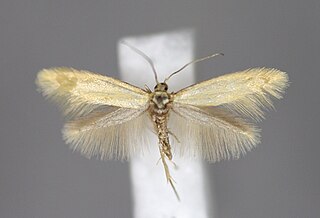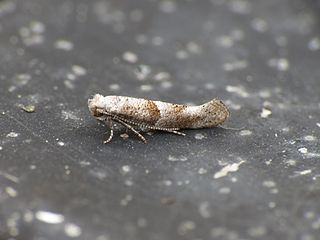| Cedestis gysseleniella | |
|---|---|
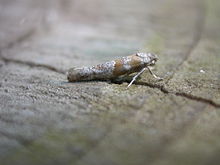 | |
 | |
| Scientific classification | |
| Kingdom: | Animalia |
| Clade: | Euarthropoda |
| Class: | Insecta |
| Order: | Lepidoptera |
| Family: | Yponomeutidae |
| Genus: | Cedestis |
| Species: | C. gysseleniella |
| Binomial name | |
| Cedestis gysseleniella (Zeller, 1839) [1] | |
| Synonyms | |
Cedestis gysseleniella is a moth of the family Yponomeutidae. It is found in Europe [1] and parts of Russia. [3]

Moths comprise a group of insects related to butterflies, belonging to the order Lepidoptera. Most lepidopterans are moths, and there are thought to be approximately 160,000 species of moth, many of which have yet to be described. Most species of moth are nocturnal, but there are also crepuscular and diurnal species.
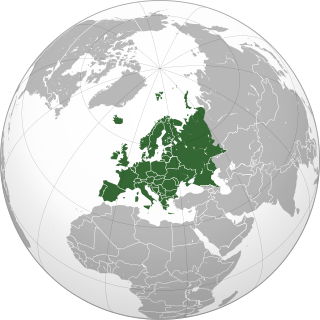
Europe is a continent located entirely in the Northern Hemisphere and mostly in the Eastern Hemisphere. It is bordered by the Arctic Ocean to the north, the Atlantic Ocean to the west and the Mediterranean Sea to the south. It comprises the westernmost part of Eurasia.

Russia, officially the Russian Federation, is a transcontinental country in Eastern Europe and North Asia. At 17,125,200 square kilometres (6,612,100 sq mi), Russia is the largest country in the world by area, covering more than one-eighth of the Earth's inhabited land area, and the ninth most populous, with about 146.77 million people as of 2019, excluding Crimea. About 77% of the population live in the western, European part of the country. Russia's capital, Moscow, is the largest metropolitan area in Europe proper and one of the largest cities in the world; other major cities include Saint Petersburg, Novosibirsk, Yekaterinburg and Nizhny Novgorod. Extending across the entirety of Northern Asia and much of Eastern Europe, Russia spans eleven time zones and incorporates a wide range of environments and landforms. From northwest to southeast, Russia shares land borders with Norway, Finland, Estonia, Latvia, Lithuania and Poland, Belarus, Ukraine, Georgia, Azerbaijan, Kazakhstan, China, Mongolia and North Korea. It shares maritime borders with Japan by the Sea of Okhotsk and the U.S. state of Alaska across the Bering Strait. However, Russia recognises two more countries that border it, Abkhazia and South Ossetia, both of which are internationally recognized as parts of Georgia.
The wingspan is 11–13 mm. [4] Adults are on wing from June to July [1] [4] depending on the location.[ citation needed ]

The wingspan of a bird or an airplane is the distance from one wingtip to the other wingtip. For example, the Boeing 777-200 has a wingspan of 60.93 metres, and a wandering albatross caught in 1965 had a wingspan of 3.63 metres, the official record for a living bird. The term wingspan, more technically extent, is also used for other winged animals such as pterosaurs, bats, insects, etc., and other fixed-wing aircraft such as ornithopters. In humans, the term wingspan also refers to the arm span, which is distance between the length from one end of an individual's arms to the other when raised parallel to the ground at shoulder height at a 90º angle. Former professional basketball player Manute Bol stands at 7 ft 7 in (2.31 m) and owns one of the largest wingspans at 8 ft 6 in (2.59 m).
The larvae feed on Abies alba , [1] Abies fabri , [3] Pinus mugo , [1] Pinus sylvestris , [1] [4] Pinus tabuliformis , [3] and Pinus contorta . [2] Although Vaccinium myrtillus has been listed as host plant in Gershenson and Ulenberg 1998, [1] this listing is considered "suspicious" by the more recently published Lewis and Sohn 2015. [3]

Abies alba, the European silver fir or silver fir, is a fir native to the mountains of Europe, from the Pyrenees north to Normandy, east to the Alps and the Carpathians, Slovenia, Croatia, Bosnia and Herzegovina, Montenegro, Serbia, and south to Italy, Bulgaria, Albania and northern Greece; it is also commonly grown on Christmas tree plantations in the North East region of North America spanning New England in the USA to the Maritime provinces of Canada.

Abies fabri is a conifer species in the family Pinaceae. It is endemic to Sichuan in western China, occurring on the sacred mountain of Emei Shan and westward to the Gongga Shan massif, growing at altitudes of 1,500–4,000 metres (4,900–13,100 ft).
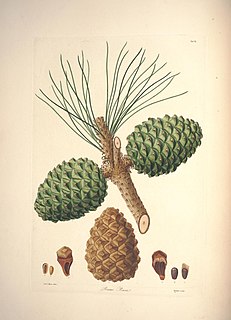
Pinus mugo, known as creeping pine, dwarf mountainpine, mugo pine, mountain pine, scrub mountain pine or Swiss mountain pine, is a species of conifer, native to high elevation habitats from southwestern to Central Europe.



